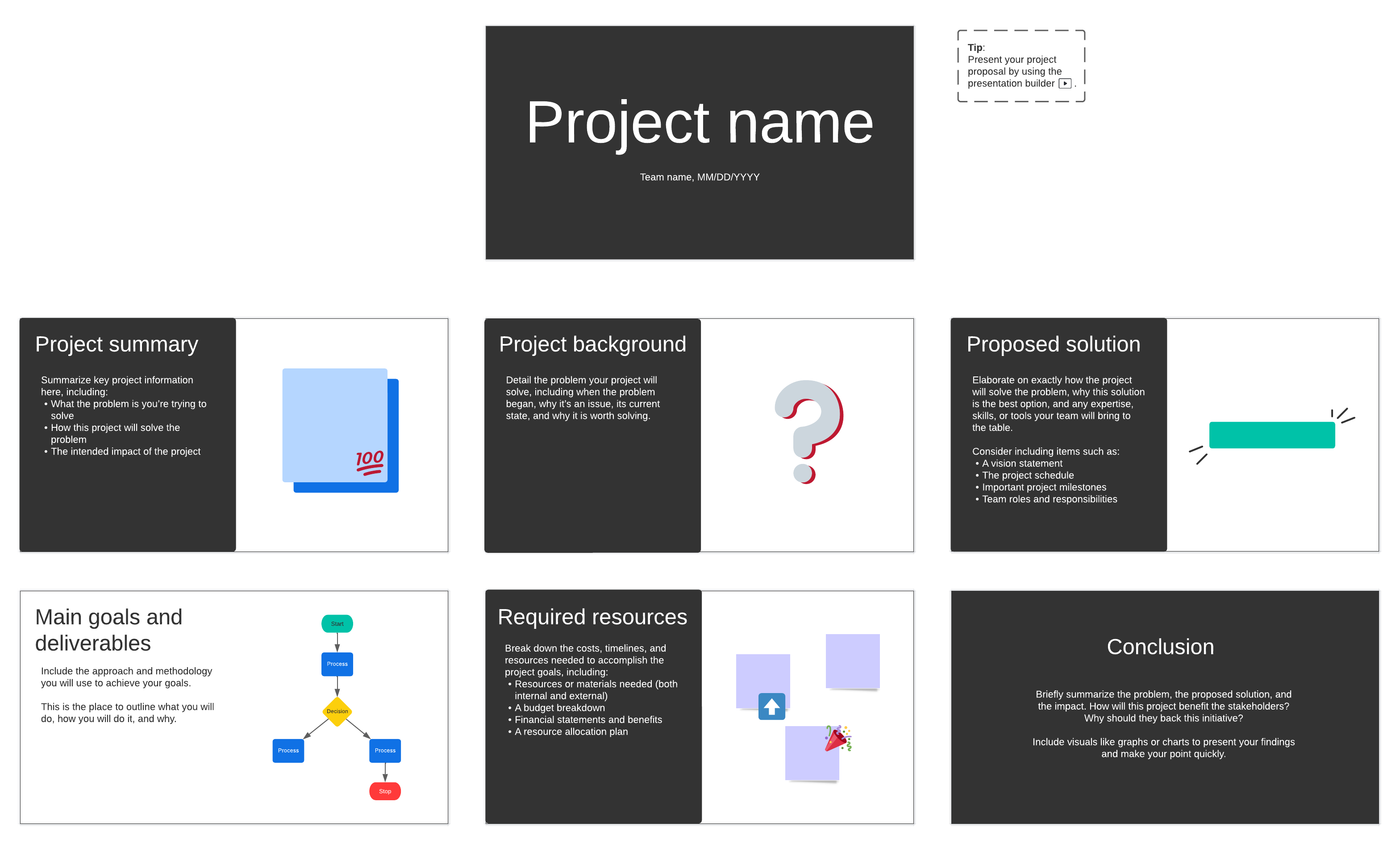So you want to launch a project. Before you roll up your sleeves, you need to get buy-in from stakeholders—whether that’s a client, a manager, or executives. But you can’t just go up and ask for permission. You need to submit a formal project proposal.
What is a project proposal?
A project proposal is basically your sales pitch for the project. It is a persuasive document that outlines the key information stakeholders need to make a decision. This includes the project goals, budget, requirements, and deliverables. A well-written project proposal should leave stakeholders excited to move forward.
Project proposal vs. project charter
Project proposals and project charters share some similarities, but they serve different purposes. A project proposal comes first. It is the document you use to persuade stakeholders to green-light the project.
Once your project is a go, then you will create a project charter. The project charter outlines the scope and goals of the project, as well as key roles and responsibilities. While some of this information is also included in the project proposal, the project charter acts as a reference document to ensure clarity and alignment throughout the project initiative.
How to write a project proposal in 7 steps
1. Summarize key project information
The first section of your proposal is called the executive summary. Here you will introduce the project’s key information, including:
- What the problem is you’re trying to solve
- How this project will solve the problem
- The intended impact of the project
Your summary should be clear, concise, and persuasive. The goal here is to spark interest and entice the stakeholders to continue reading. Keep in mind that you will be expanding on each of these points, so there is no need to go into depth here. This is just to outline the main project details.
2. Explain the problem
The next section is called the project background. This is where you will detail the problem your project will solve, including when the problem began, why it’s an issue, its current state, and why it is worth solving.
Again, keep this section short and to the point. Typically, project backgrounds are no more than one page (or a few paragraphs) in length. Remember: This is supposed to be a persuasive document, so choose what details and information to include carefully. Use data to back up any claims and highlight your points.
3. Propose a solution
With the problem clearly defined, it's time to propose your solution. This section elaborates on exactly how the project will solve the problem, why this solution is the best option, and any expertise, skills, or tools your team will bring to the table.
Consider including items such as:
- A vision statement
- The project schedule
- Important project milestones
- Team roles and responsibilities
This is where you should address any questions or objections stakeholders may have. For example, if your project is more expensive or requires a greater investment of resources, use this section to defend your proposal and underscore why this is the better solution.
4. Outline the main goals and deliverables
Here you will go into more detail about the scope of the project and how you will execute it. This includes what approach and methodology you will use to achieve your goals.
Be sure to define:
- The project goals
- The specific work to be done and the deliverables to expect
- Who the decision-makers are and whose approval is needed
- Potential risks and plans to mitigate them
- The project’s success criteria
As you define your approach, describe your project strategy and any methodologies or frameworks you plan to use. For instance, will you use an Agile methodology? Or perhaps a waterfall approach? Why? Who will do the work? An in-house team or contractors?
This is the place to outline what you will do, how you will do it, and why. The “why” here is especially important. The better you can defend your reasoning, the more likely you will persuade the stakeholders to get on board with your vision.
5. Define the resources you will need
Next in writing your project proposal, break down the costs, timelines, and resources needed to accomplish the project goals. This section should include:
- Project requirements, such as resources or materials needed (both internal and external)
- A budget breakdown, including an itemized budget of all external and internal project expenses
- Financial statements, including a cost-benefit analysis to demonstrate the financial benefits
- A resource allocation plan detailing where specific resources will be used (e.g., materials, salaries, administration, technology, etc.)
Research this information carefully to ensure your calculations and estimates are as accurate as possible. The better you can plan for the resources required, the greater the chance of success.
6. Write a persuasive conclusion with data to back you up
Finally, tie it all together with a concluding section that briefly summarizes the problem, the proposed solution, and the impact. How will this project benefit the stakeholders? Why should they back this initiative? You don’t want to wax too redundant here, but this is your chance to emphasize the most important points of your proposal.
In other words, what do you want stakeholders to remember? What evidence do you have that the proposed solution is necessary and effective? Use any facts, figures, or other data you have to support your claims and further demonstrate the value of the project. This is a good place to include visuals like graphs or charts to present your findings and make your point quickly.
7. Edit and review
Breathe a sigh of relief. Your proposal is done! Well…almost. Before you share it, go through the proposal again to check for quality and clarity. This includes proofreading for basic errors but also reviewing your proposal structure and writing quality. Editing is one of the most important steps to take your proposal to the next level.
A few things to check for:
Readability: Your proposal should be thorough but concise. Keep in mind that stakeholders often skim through the information, so review the writing to make sure your main points are clear and easy to find from a quick read-through.
- Use formatting like bold text, bullet points, or headings to highlight main points and sections.
- Add visuals to illustrate your points and break up the text.
Clarity: Improving readability should help with clarity. But go through the proposal again to assess the writing on the paragraph and sentence level.
- Rework and shorten any long or unwieldy sentences.
- Break up big blocks of text to make it easier to read and digest paragraphs.
- Vary sentence length to improve flow.
- Correct any unclear or awkward sentences.
- Limit technical language and jargon.
Tone and voice: Your word choice and writing style add a specific tone and emotional context. Nailing the tone is critical for persuasive writing, so review the proposal to make sure the tone and voice align with your target audience and the impact you want to have.
For example, avoid technical writing, which can feel dry and impersonal, in favor of business writing, which is more conversational.
- Minimize passive voice.
- Use first and second person (e.g., you, we) to create a connection between you and the reader.
- Don’t overdo the sales language. Embellishing your proposal with hyped-up language or superlatives will come off empty and insincere. Instead, rely on evidence and facts to substantiate your claims and do the heavy lifting.
Impact: How persuasive is your proposal? How well did you communicate your message? Be careful not to “bury the lede” or hide the most important part of the story under superfluous or irrelevant details.
Your proposal should ultimately tell a story. Each section should work together cohesively to further the narrative and underline your main message. Does it flow well? Is there a logical progression from point to point?
Review your work to assess the overall impact of the story you’ve told and refine it as needed.
Okay, now you can breathe that sigh of relief.
How Lucidspark can help you write a project proposal
Proposals often have a bad rap for being stodgy and boring. But they don’t have to be. Impress your clients, team, or management with your next proposal with the help of Lucidspark.
Create your proposal right in Lucidspark. Lucidspark’s infinite canvas gives you the creative space to visualize your data, illustrate your points, and easily share your work all from one place. Get started with the template below.

Add images, GIFs, and even freehand drawings on the canvas to bring your proposal to life. Facilitator tools allow you to present your board and collaborate with team members more easily before presenting to stakeholders. Use features like the laser pointer to call out key points and Broadcast to send announcements to the entire group.
You can even embed information from other project management platforms you use, so you can pull all your data into your proposal from one place.
Project proposals are all about helping stakeholders see your vision. Capture your vision in Lucidspark.

Create your own project proposal in Lucidspark.
Use templateAbout Lucidspark
Lucidspark, a cloud-based virtual whiteboard, is a core component of Lucid Software's Visual Collaboration Suite. This cutting-edge digital canvas brings teams together to brainstorm, collaborate, and consolidate collective thinking into actionable next steps—all in real time. Lucid is proud to serve top businesses around the world, including customers such as Google, GE, and NBC Universal, and 99% of the Fortune 500. Lucid partners with industry leaders, including Google, Atlassian, and Microsoft. Since its founding, Lucid has received numerous awards for its products, business, and workplace culture. For more information, visit lucidspark.com.
Related articles
Importance of using milestones in project planning
In this post, we’ll cover the basics of project milestones, focusing on two questions: What is a project milestone? And why are project milestones an important element of project planning?
How to create a project communication plan
In this article, we will cover what a project communication plan is, and how to write your own.
How to write an executive summary (example of an executive summary + free template)
We’ll teach you how to write an executive summary and provide a foolproof template to remove the guesswork.

